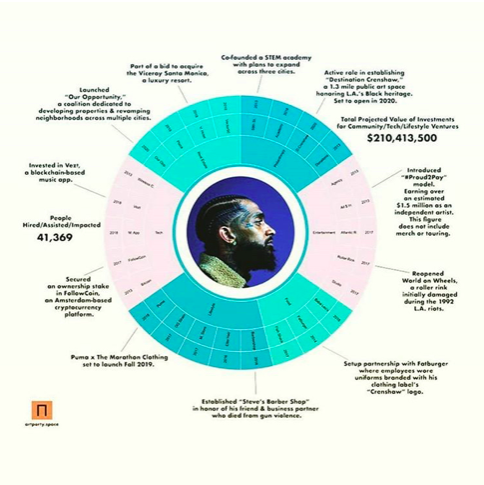Nipsey Hussle exemplified how Black people, globally, use cooperative economics and a politics of ownership to create necessary services and local economies in our communities / neighborhoods. These are usually the same neighborhoods cities often neglect until there is potential for gentrification. Our environment is much more than the air we breathe, it is also the health and vibrancy, or lack thereof, in our neighborhoods.
Nipsey Hussle was my brother’s favorite rapper. I did not know this until he died. My brother, who lives in the Valley in Los Angeles County, was deeply upset by Nipsey’s murder. When sharing his feelings about Nipsey’s death, my brother emphasized how much he had done for his community. The place he lived and died in. It was exactly the environment Nipsey grew up in that created the circumstances of his murder, as well as the need for his investment in that area. Desperation, fabricated scarcity, and psychological stress induced by capitalism’s omnipotence.
Nipsey’s death is a crucial reminder that spatial inequity is a form of violence. When our environment is designed so that we are not able to thrive, we end up killing each other in an attempt to claim a little piece of what should be all of ours—but few of us have access to. Around the world, but in this case in the United States, the forsaking of poor neighborhoods and self-built communities is a form of environmental and psychological violence.
This economic stress and ambition had Nipsey selling mixtapes out of the back of his car in a parking lot, the same parking lot he later redeveloped. He transformed it from a place of scarcity and vacancy to a place of viability. Nipsey was essentially remapping his neighborhood in South Los Angeles, on Slauson Avenue, by his economic investments.
In working class Black areas the police act as an extension of state-sanctioned military violence forced upon the hood. Nipsey wanted the police to work with residents in the hood—as if they lived there—rather than as overseers expecting the worse. Rather than being a force of fear and violence, he wanted to make the police partners in keeping the hood safe. This is what police are actually supposed to do and often they do this in wealthy areas… help the community keep themselves safe. Nipsey wanted to decrease the fear and stress residents were walking around with because he knew how dangerous it was. As Nipsey was redeveloping his neighborhood, he wanted to improve relations with the police so that his community has more opportunities for safety and protection. Can you imagine how a place could transform if people felt safe, protected, and like they belonged there?
Nipsey reopened a skating rink that was damaged in the L.A. Riots. This created more recreational, family-inclusive activities for residents. Giving them more things to do in close proximity. The possibility for trouble is heightened when there is not affordable safe activities in accessible locations in our neighborhoods. It is ironic that the skating rink he reopened was damaged during a time when Black, Brown and immigrant communities in Los Angeles were protesting against the policies and laws that created the circumstances of the neighborhood Nipsey grew up in. By reopening this ice skating rink, opening other stores in the neighborhood, partnering with community organizations and more, Nipsey changed the cultural, social and economic geography of his neighborhood. He translated that sense of ownership, which often Black people feel in our hoods, into the literal economic ownership of our hoods.
When you own something, you treat it differently and you want it to survive… thrive even. When you own nothing, you have nothing to lose so violence becomes more tangible. When we own our hoods, we are more accountable to one another—that is what a true community is. By investing in his community to create relevant services and activities, something that the city of Los Angeles failed to do on Slauson Avenue, Nipsey showed us all that collective ownership can save lives. Feeling ownership and actually having ownership over the spaces he inhabited growing up—saved his life… until it didn’t.
Unfortunately Nipsey could not transform the hood alone. He was working against forces beyond his direct control. Forces like: conservative policies, tax cuts, and the racist-classism inherent in American urban planning. These forces produce the invisible structures that create the circumstances for inter-community violence. The type of violence by which Nipsey was murdered.
If we collectively own and manage all of the places and spaces in our communities, then we can do what Nipsey was trying to do: transform our neighborhoods into geographies of opportunity, solidarity, and cooperative wealth. Lauren London, Nipsey’s partner in life and love, said it best “the marathon continues.” And it must! The only way we are going to save the hood is investing in it together, resisting the forces that degrade our spaces, and remapping / taking space until we have a better environment. Hopefully The Hussle, the Nipsey Hussle, will now mean cooperative economics and hood-determination.
